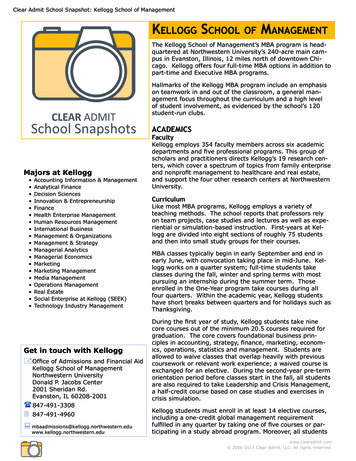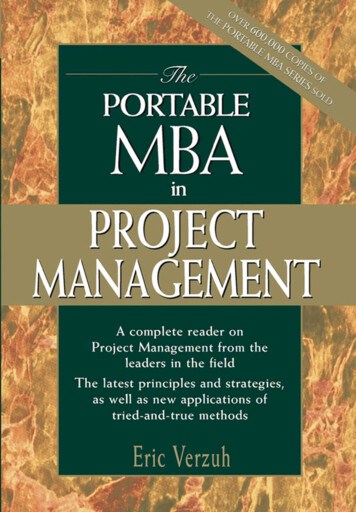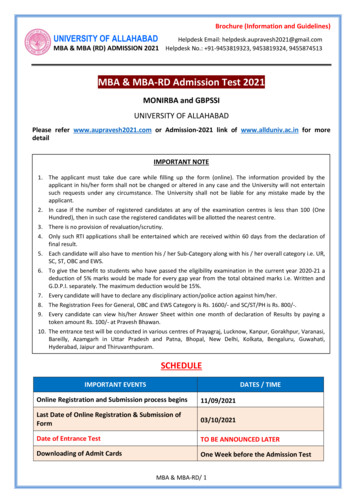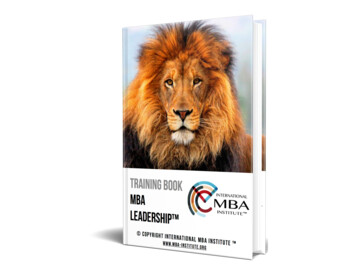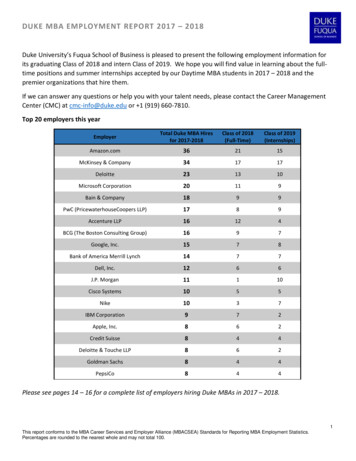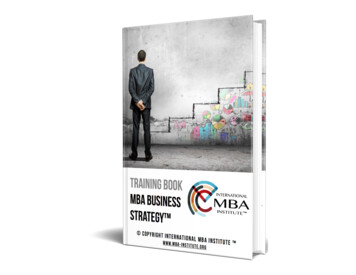
Transcription
MBA BUSINESS STRATEGY DEGREETRAINING BOOKSECOND EDITIONBY INTERNATIONAL MBA INSTITUTE www.mba-institute.org COPYRIGHT INTERNATIONAL MBA INSTITUTE
DedicationTo all of the International MBA Institute students, thank you for inspiring us, keeping usfocused, and making sure we do our best to help you grow in your career with your skillsand knowhow. Without you, your engagement and your loyal support, International MBAInstitute could not come where it is today.
TABLE OF CONTENTSCLICKABLEWELCOME .5ABOUT INTERNATIONAL MBA INSTITUTE .6Introduction .7The Evolution of the Concept of Strategy .9Competing on Capabilities and the Resource-Based View .15The Concept of Core Competence .18The Concept of Strategic Intent .23Intended and Realized Strategies .28The Three Levels of Strategy .31Developing a Strategic Perspective .34Introduction to Strategic Management .36Components of Strategy Formulation .44Strategic Decision-Making .48Thank you .52
WELCOMEHi! I’m Yeliz.I love that you are taking your time to read your MBAbook. I want to briefly share with you why we wantedto write this book for you and how you can get thebest use out of it.Within the context of our MBA degrees we made athorough research in MBA education space.The conclusion was: We failed to find one singletextbook, we could sincerely recommend to ourstudents!We talked to our successful students and found outthat, almost none of the MBA books in the marketcould really help them make a smooth entry to MBAknowhow and practical business execution space.Significant number of MBA books in the marketplaceclaim that they cover all details of MBA, but whatthey are not telling is that, they don't haveunderstandable, clear and logical content to helptheir readers comprehend and most importantly loveMBA!Therefore, we wrote for you MBA books and broughtthem for your service!We are absolutely confident that your MBA books willmake you proficient in MBA subjects, so that you willhave an outstanding opportunity to love MBA andkeep on taking the tangible benefits of being an MBAprofessional.Take some coffee to enjoy and some paper totake your notes, and spend some quiet time toread your MBA books!Afterwards you will have a great understandingabout MBA domains and be prepared to pass yourMBA degree exam. You will be ready to deliver greatproducts and services to your clients and employersand to build your bright career and future!Yeliz ObergfellVice President - Student ExperienceInternational MBA Institute 5
ABOUT INTERNATIONAL MBA INSTITUTE International MBA Institute is an independentinstitute which helps organisations and professionalsget accredited with worldwide renowned and validMBA degrees and prove their competence in MBAdomains. We empower professionals worldwide tobuild their careers, and companies to create and selltheir outstanding products and services.Your MBA Leadership , MBA Management , MBASales , MBA Human Resources , MBA Finance ,MBA Marketing , MBA Business Strategy and MBARecruitment degrees have proven their worldwideacceptance and reputation by being the choice ofmore than 987’000 MBA professionals in 143countries.MBA is a set of open business execution, product,service delivery and leadership frameworks, and yetbefore International MBA Institute was established,there used to be no reasonable way for MBApractitioners like yourself to obtain your accreditedMBA degrees and to prove your competence in MBAdomains. MBA practitioners had to pay expensivefees for the one way profit-driven MBA degrees ofother MBA education providers.International MBA Institute aims to remove thesebarriers set in front of the MBA professionals indeveloped and emerging markets by saving themfrom paying unreasonable fees for MBA classroomtrainings and MBA degree examinations before theyaccredited their knowhow in MBA Domains.Moreover, feel free to check out "What makes YourMBA Degrees Best of the Industry?" section on ourwww.mba-institute.org web portal to read why weperform and serve you far more better than ourcompetition.International MBA Institute provides 8 major onlineMBA degrees which are designed by our consortiumof renowned business and people Leaders, coaches,mentors, experts and authorities from all majorindustries. You can check your MBA degrees fromthis List of MBA Degrees.6
IntroductionIn this chapter, you will: Understand the importance of BusinessStrategyenvironment, it is not good enough if the seniormanagement’s principal aim is to build an enduringorganization.It is easy for you to be successful once, but it isdifficult to stay successful perpetually. Corporatehistory is replete with examples of organizationswhich were successful at one point of time, butwhich could not continue to survive in themarketplace. One of the reasons for corporatemortality is excessive focus on the present andignoring or paying little attention to the future and itschallenges. In the intensely competitive globalenvironment of today, your organization/firm shouldhave strategies that provide the framework for longterm success. It is the goal of strategic managementto create an enduring organization.Competing For The FutureGary Hamel, a leading authority on strategicmanagement and co-author of the book ‘Competingfor the Future', estimated that American seniormanagers generally spend about 3 percent of theirtime thinking and planning for the future. While 3percent may be sufficient if you want to achieveshort-term objectives in a stable businessThe dynamic nature of the environment oftenrenders the strategy being pursued by a firmredundant and there is a need for it to be replacedwith new strategies. For example, till the mid-1980s,the Indian passenger car sector had three players,namely, Standard Motors, Premier Automobiles Ltd.7
(PAL), and Hindustan Motors Ltd. Maruti Udyog Ltd.entered the industry in the mid-1980s and went onto become the market leader in a short span of time.Its cars outperformed those of the existing playersand PAL had to shut shop as it was not able to copewith the competitive pressures.The early 1990s witnessed the opening up of theIndian car industry; global players like Hyundai, Ford,General Motors, Fiat, Mitsubishi, and Toyota amongothers entered the Indian car market. Tata Motorsand Mahindra & Mahindra too entered thepassenger car market. Maruti Udyog Ltd. had to faceintense competition from the new players. Its abilityto launch new cars and models along with a strongdistribution and service network helped it to retainits leadership position. In order to survive, HindustanMotors tied up with Mitsubishi Motors.success of a particular strategy is dependent on theintensity of competition in the marketplace. Instrategic management, you deal with the issues ofstaying perpetually successful. You deal with how afirm utilizes its resources and capabilities to counteror pre-empt competitive moves and succeed in thedynamic marketplace.Summary:1 The goal of strategic management is to createan enduring organization.2 The dynamic nature of the environment oftenrenders the strategy being pursued by a firmredundant.Tenure of success of a particular strategy isdependent on the intensity of competition in themarketplace.In 2009, Tata Motors launched the world’s lowestpriced car Nano. This disruptive innovation forcedsome of its competitors to take a relook at theirproduct portfolio and strategic direction for thefuture.Different firms pursue a variety of strategies to staysuccessful over a period of time as the tenure of8
The Evolution of the Concept ofStrategyIn this chapter, you will: Learn Ansoff’s Strategic Success Paradigm Learn Mintzberg: Strategy as Craft Learn Peter Drucker’s Contribution to theconcept of Strategy Learn about Michael Porter: Strategy andSustainable Competitive AdvantageThe word Strategy comes from the Greek wordStrategia, which means a General or MilitaryCommander. War and strategy are inseparable.Wherever there has been war, there has been astrategy to wage it. War and strategy are not newconcepts; what is new is the increased emphasis onstrategy in the business context. Every businessstrategy that is hammered out in the boardrooms ofan American, Asian, or European company can betraced back to a battlefield of a past war as shownbelow.Impact of War on Business StrategiesToday’s successful business strategies can be tracedback to military strategies that have been usedeffectively from ancient Greece to the 21st century.For example, the following strategic principlescontinue to be relevant across changes in time andcontext.123Attack Strength: Attack the enemy in hisstronghold. The Japanese attack on PearlHarbour is an example of this principle.Similarly, in the 1990s, Lexus (Toyota)successfully fought Cadillac (GM) and Lincoln(Ford) in the US luxury car market.Attack Weakness: The American attackagainst Germany in Morocco during theSecond World War is an example of thisstrategy. The Nazis ignored the impending USattack on Morocco, thinking that Morocco washardly worth defending. The successfulAmerican attack on Morocco opened up theway for the ultimate defeat of Hitler in theSecond World War. Sam Walton, the founder ofWal-Mart, executed this strategy in the early1960s by opening retail stores in small townsignored by the then giant — Sears.Concentrate Your Forces: This strategy ismost relevant in today’s business scenario.Organizations should coordinate theirresources and concentrate on the areas wherethe competition is most intense. Using this9
45strategy, in ancient times, generals like Caesarand Genghis Khan overwhelmed rivals withmuch bigger armies. Companies like Nike andFedEx excel because of their concentrationstrategy.Forge a Strategic Alliance: The allianceamong the US, the UK, and the USSR overcameNazi Germany in the Second World War.Similarly, in today’s highly competitive businessenvironment, organizations are increasinglyentering into alliances and forming businessnetworks to take advantage of varioussynergies.Sometimes, Containments Good Enough:The Cold War between the US and theerstwhile USSR during the second half of the20th century is an example of Containments t ra t e g y. I n b u s i n e s s , w h e n t h e re i scompetition between two organizations ofequal size, if one organization tries to eliminatethe other, then both firms will end up withshattered profit margins and mountains ofdebt, and, in the end, bankruptcy. So,containment is often preferred.Todays Success Strategies10
Igor Ansoff pioneered the concept of strategy. Later,Henry Mintzberg, Michael E. Porter, and othersenriched the concept of strategic management withtheir original insights.Strategic Management GurusAnsoff’s Strategic Success ParadigmThe systematic study of strategy was pioneered byIgor Ansoff conducted extensive research onacquisitions by American companies between 1948and 1968. He found that acquisitions based on arational strategy fared far better than those thatwere based on opportunistic decisions.Ansoff‘s strategic success paradigm identifies theconditions that optimize profitability. The keyelements of this paradigm are as follows:1 There is formula for all firms.2 The level of turbulence in the environmentdetermines the strategy required for thesuccess of your firm.3 The aggressiveness of the strategy should bealigned with the turbulence in the environmentto optimize your firm’s success.4 The management’s capabilities should bealigned with the environment to optimize yourfirm’s success.5 Internal capability variables, that is, cognitive,psychological, political, anthropological, andsociological variables, all jointly determine yourfirm’s success.After 11 years of testing his strategic successparadigm empirically, Ansoff translated it into adiagnostic instrument called ‘Strategic ReadinessDiagnosis’. His book ‘Corporate Strategy’ (1965)played a key role in the development of the concepto f s t ra t e g i c p l a n n i n g . H e i n t ro d u c e d ‘g a panalysis’ (the gap between where the company istoday in terms of growth and aspirations and whereit wants to be) and the concept of synergy to a wideaudience for the first time. He also proposed the11
Ansoff Product/Market Grid, also known as theAnsoff Matrix, to depict four growth strategies —market penetration, market development, productdevelopment, and diversification.Mintzberg: Strategy as CraftThe next great influential thinker in the field ofstrategic management after Ansoff was HenryMintzberg. Mintzberg added a new dimension tostrategic management by bringing the personal sideof the manager into the picture. He proposed anintuitive view of strategic management, and attackedthe rationalism of his contemporaries with regard tothe subject. In his first book, The Nature ofManagerial Work (1973), he advocated a morehumane approach to strategy formulation andimplementation, and coined the term ‘craftingstrategy’. He drew a parallel between a craftsman,potter, and a manager who is crafting strategy. Heproposed that the manager is aware of the corporatecapabilities and the future market opportunitieswhich are taken advantage of by him/her, using his/her knowledge. Accordingly, a manager while craftingstrategy may start with a pre-planned deliberatestrategy but while implementing it, may use his/hercapabilities to sense changes required in the strategydue to the dynamic nature of the environment andmay craft a new strategy, different from the one he/she started with.Mintzberg saw strategy formulation as a deliberate,delicate, and dangerous process, and advocated thatstrategies are both plans for the future and patternsfrom the past.In 2005, Kodak was ranked number 1 in digitalcamera sales in the United States. Its digital camerasales had touched US 5.7 billion. It was productinnovation which enabled Kodak to achieve thisstatus. However, by 2007, Antonio M. Perez, Kodak’sChief Executive Officer, was disillusioned with the lowprofitability of the digital camera business. This wasbecause, though the fast paced growth of camerasales had countered the fast-fading film revenues, itwas not in a position to replace the rich profits of itsfilm business. The best mass market cameras yieldedslim profit margins. Accordingly, though Kodak’sdigital camera business was a roaring sales success,it was a major profit disappointment. Perez begancrafting yet another strategy for Kodak, its third inless than a decade. Kodak started working on arange of new digital photo services for consumersthat were expected to yield higher returns andincluded everything from online photo sharing to a12
rapid-fire scanning system, called Scan the World,that converts old pictures into digital imagesorganized by the date originally printed.of management; it is a philosophy of managing. MBOtransformed the basic assumptions of managingfrom exercising control to self-control.Peter Drucker’s ContributionAfter World War II, the use of formal strategicthinking to guide management decisions wasencouraged. Peter F. Drucker argued that“management is not just passive, adaptive behavior;it means taking action to make the desired resultscome to pass.”Michael Porter: Strategy and SustainableCompetitive AdvantageMichael Porter (Porter) is a leading authority oncompetitive strategy, and on the competitivenessand economic development of nations, states, andregions. In his book ‘Competitive Strategy’ (1980),Porter addressed the issue of how your firm analyzesindustries and competitors and develops itsstrategies accordingly. He proposed that competitivestrategy is about being different. Being different hererefers to the manner in which customers perceiveyour firm to be distinct from your competitors.Hence, strategy is about positioning your firm in thecustomer’s perspective. In his book ‘CompetitiveAdvantage’ (1985), he addressed the issue of firmscreate and sustain superior performance, that is,build a sustainable competitive advantage.Drucker expected managers to influence and controlmarket forces. He said, “It (managing) impliesresponsibility for attempting to shape the economicenvironment, for planning, initiating, and carryingthrough changes in that economic environment, forconstantly pushing back the limitations of economiccircumstances on the enterprise’s freedom of action.”Drucker ’s biggest contribution to strategicmanagement was the introduction of the concept ofmanagement by objectives (MBO). When Druckerintroduced the concept in 1954, most managerswere concerned with processes rather than goals.With MBO, the focus shifted from processes to goals.According to Drucker, MBO is more than a techniquePorter ’s important contributions to strategicmanagement include the ‘Five Forces model’, the‘value chain’ concept and the concept of ‘genericstrategies’. According to the ‘Five Forces’ model’, thenature and degree of competition in an industry13
depends on five forces: the threat of new entrants,the bargaining power of customers, the bargainingpower of suppliers, the threat of substitute products,and the rivalry between existing players. Todetermine a strategic plan for growth in yourbusiness environment, an organization mustunderstand how these forces operate in the industryand affect the company-specific situation. Porterproposed assessing every activity of your company interms of its overall competitiveness. Further, heproposed the use of value chain analysis of youro rg a n i z a t i o n’s i n t e r n a l p ro c e s s e s , a n d t h einteractions between different functions, todetermine how and where value could be added forthe customer by your company. He also advocatedthree generic strategies: overall cost leadership,differentiation, and focus, which help yourorganization to compete effectively in themarketplace. These strategies determine the basis ofcompetition.3implementation, and coined the term ‘craftingstrategy’.Peter F. Drucker argued that “management isnot just passive, adaptive behavior; it meanstaking action to make the desired results cometo pass.”Porter ’s important contributions to strategicmanagement include the ‘Five Forces model’, the‘value chain’ concept and the concept of ‘genericstrategies’.Summary:1 Ansoff found that acquisitions based on arational strategy fared far better than thosethat were based on opportunistic decisions.2 Mintzberg advocated a more humaneapproach to strategy formulation and14
Competing on Capabilities and theResource-Based ViewIn this chapter, you will: Understand the ability for your firm to besuccessfulThe ability of your firm to succeed today depends onits capability to move quickly in and out of products,markets, and at times from entire business areas.Success depends on anticipation of market trendsand responding quickly to the changing customerneeds. This is enabled when your firm builds itsstrategic capabilities around key business processesand not functional areas. For a capability to beconsidered strategic, it should be focused on thecustomer.A firm which strategizes on the basis of thecapabilities it possesses will enjoy clear advantagesin terms of speed, agility, acuity, consistency, andinnovativeness.According to George Stalk, Philip Evans, andLawrence E. Shulman, the four-basic principles ofcapabilities-based competition are:“The building blocks of corporate strategy are notproducts and markets but business processes.Competitive success depends on transforming acompany’s key processes into strategic capabilitiesthat consistently provide superior value to thecustomer. Companies create these capabilities bymaking strategic investments in a supportinfrastructure that links together and transcendstraditional Strategic Business Units (SBUs) andfunctions. Because capabilities necessarily crossfunctions, the champion of a capabilities-basedstrategy is the CEO.”In a capabilities-driven firm, senior managementdoes not tell managers what to do. Rather, theycreate an environment where they can learn fromthe market and from each other. An environment isbuilt in which the capabilities are rooted as theprimary object of strategy.One such firm is Dell, which created capabilities(competitive advantages) by utilizing the Internet andbreaking the functional barriers. At a time, whenpersonal computers (PC) were being sold byintermediaries, Dell used the internet to enablecustomers to design their own PC on the internetand place orders online. This eliminated the need for15
intermediaries like dealers and resulted in costsavings for the firm. It further used electronic links tointegrate with its vendors like Sony to dispatchshipments of computer monitors directly to thecustomers instead of shipping them to a warehouseand re-routing to the customers, which resulted infurther cost savings for Dell. These capabilities gaveDell a competitive advantage over its competitors inmany countries.These capabilities, along with valuable assets –tangible and/or intangible – that can provide acompetitive advantage, are together referred to as‘resources’ in strategy literature. For a resource to bevaluable and provide a competitive advantage to thefirm, the market demand for the resource should behigh, market availability should be low, and your firmshould have the bargaining power to capture thevalue that is created by the resource. Further, suchresources should be durable, superior to similarresources possessed by competitors, and difficult toimitate/copy or substitute. Resources form thefoundation of the resource-based view (RBV) of yourfirm which visualizes strategy as a choice thatmatches what your firm can do (given its resourcesand capabilities) with the competitive environment(in terms of Porter’s Five Forces).Porter's Five ForcesSummary:1 Success depends on anticipation of markettrends and responding quickly to the changingcustomer needs.2 In a capabilities-driven firm, seniormanagement does not tell managers what todo. Rather, they create an environment where16
3they can learn from the market and from eachother.For a resource to be valuable and provide acompetitive advantage to the firm, the marketdemand for the resource should be high,market availability should be low, and yourfirm should have the bargaining power tocapture the value that is created by theresource.17
The Concept of Core CompetenceIn this chapter, you will: Identify the factors of core competence U n d e r s t a n d t h e a p p l i c a b i l i t y o f c o recompetence in Emerging marketsIn 1990, C. K. Prahalad and Gary Hamel, in theircelebrated article, ‘The Core Competence of theCorporation”, introduced the concept of corecompetence. They defined core competencies as the“collective learning in the organization, especiallyhow to coordinate diverse production skills andintegrate multiple streams of technologies.” Corecompetence is also about the organization of workand the delivery of value. Miniaturization, one ofSony’s core competencies, was brought to itsp ro d u c t s by e n s u r i n g t h a t t h e c o m p a n y ’stechnologists, engineers, and marketers had ashared understanding of customer needs andtechnological possibilities.Prahalad and Hamel studied GTE and NEC to putforward their views on core competence. In the early1980s, GTE was well placed in the evolvinginformation technology industry. In 1980, GTE’s saleswere US 9.98 billion, much higher than NEC’s US 3.8 billion. However, in 1988, NEC outperformed GTE.In 1988, NEC’s sales were US 21.89 billion, muchhigher than GTE’s US 16.46 billion. According toPrahalad and Hamel, the difference in the way NECand GTE conceived of themselves — the former as aportfolio of competencies (especially insemiconductors) and the latter as a portfolio ofbusinesses — could also be observed in many otherindustries.Prahalad and Hamel are of the opinion that while inthe short run, your company’s competitivenessdepends on the price/performance attributes of itsproducts, in the long-run, competitiveness dependson the ability to build core competencies faster thancompetitors and at a lower cost. Your company’scompetitive advantage depends on themanagement’s ability to consolidate technologiesand production skills into competencies. Thecompetencies would empower individual businessesto adapt quickly to opportunities.Core competence involves communication,involvement, and a deep commitment to workingacross organizational boundaries. It involves peopleat all levels and all functions. Unlike physical assets,18
core competence does not reduce with use. In fact, itgrows when applied and shared.The Process Of Core CompetenciesIdentifying a core competenceA core competence in a company can be identifiedby applying three tests. A core competence must:1 have the potential to provide access to avariety of markets;2 m a ke a c o n t r i b u t i o n t o p re c o n c e i v e dconsumer benefits of the end product;3 be difficult for a competitor to copy.For example, if your company’s core competence issaid to be the manufacture of display systems, itshould be able to participate in diverse businessessuch as calculators, miniature TV sets, and monitorsfor laptop computers. Though a competitor may beable to copy some technologies that comprise a corecompetence, it should find it difficult to copy thecomprehensive pattern of internal learning andcoordination.Developing a core competenceTo develop core competence, your company neednot spend more on R&D than its competitors. In1983, when Canon beat Xerox in the copier business,its R&D spend on reprographics was much less thanthat of Xerox. NEC also spent less on R&D as apercentage of sales than most of its American andEuropean competitors. According to Prahalad andHamel, core competence also does not mean sharingcosts, such as two or more SBUs using a commonfacility, e.g., plant, service facility, sales force, orcommon component. Sharing of costs is an effort torationalize production across existing businesses,and not part of a predetermined effort to buildcompetencies.When NEC aimed at making semiconductors themost important “core product” of the company, itentered into strategic alliances to build competencesat low cost. Most collaborative arrangements aimedat gaining access to the required technology. NEC’smanagers seemed to understand the rationale forsuch alliances and the goal of internalizing partnerskills.19
Redefining core competenceAccording to a McKinsey Quarterly article, “Is YourCore Competence a Mirage?”, while most examplesin Prahalad and Hamel’s article referred toknowledge of one or more technologies, executiveshave extended the idea of core competence toinclude many types of skills and functions likeprocess engineering, production, new product ideageneration, and even corporate identity. In thearticle, the authors defined core competence as “acombination of complementary skills and knowledgebases embedded in a group or team that results inthe ability to execute one or more critical processesto world-class standard.”According to the authors of this article, corecompetences can be grouped into two categories:insight/foresight competences and frontlineexecution competences. Insight/foresightcompetences enable your company to learn factsthat create first-mover advantages. Insights can bederived from technical or scientific knowledge suchas optics knowledge and miniaturization ability, (e.g.,Canon), proprietary data, flair for inventingsuccessful products (such as displayed by 3M), andsuperior analysis and inference which may result inoutstanding returns (as in the case of BerkshireHathaway).A frontline execution competence refers to theunique ability to deliver products and services whosequality is equal to the best that could have beenproduced under ideal circumstances. Examples offrontline competences can be seen at Nordstrom,the retailing giant. Its ability to satisfy customers isan example of frontline competence. Nordstromstores achieve high levels of service because of theactions and decisions of hundreds of members ofthe sales force.It is possible for insight/foresight and frontlinecompetences to co-exist in the same company. Buteach would require its own managerial focus. Forexample, McDonald’s uses its frontline executioncompetence to improve its food delivery system atindividual restaurants and uses its insight/foresightcompetence to identify sites for its outlets.Applicability to emerging marketsThe application of the concept of core competence tostrategy suggests that your company should ‘focus’on serving its markets based on a portf
Sales , MBA Human Resources , MBA Finance , MBA Marketing , MBA Business Strategy and MBA Recruitment degrees have proven their worldwide acceptance and reputation by being the choice of more than 987’000 MBA professionals in 143 countries. M
